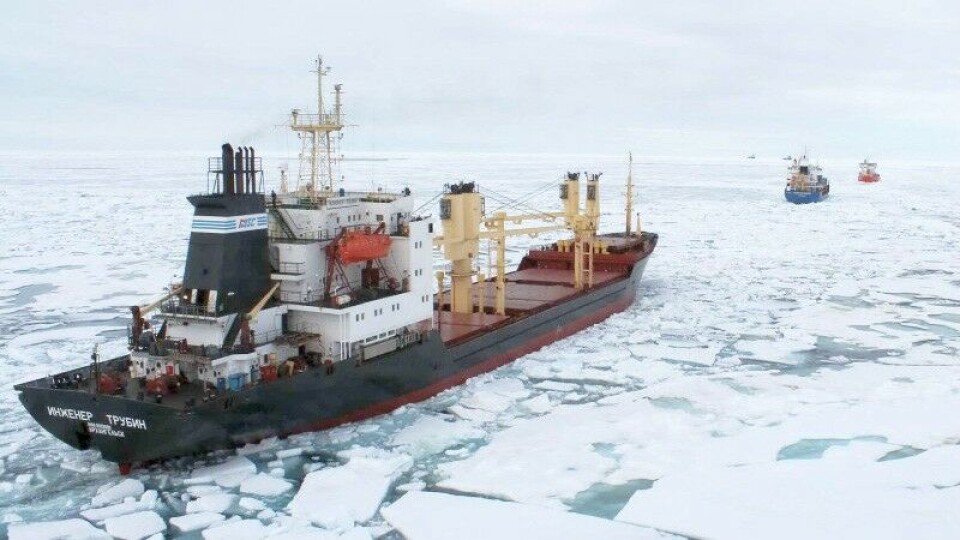
Arctic Shipping Routes: Russia’s Challenges and Uncertainties
In March 2021 with global attention focused on the mega-container ship Ever Given stuck in the Suez Canal, President Putin and his ministers were quick to proclaim that Russia’s Northern Sea Route (NSR) and the entire length of the Russian maritime Arctic were open for global shipping. Alternative marine routes to the Suez across the top of Russia would be shorter, safer and more efficient went the argument. Even the noted Finnish firm Aker Arctic released a new design for a small, icebreaking container ship specifically suited for NSR operations.
Now sixteen months later with an invasion of Ukraine and recent operational problems plaguing the NSR, the tables are turned on the Russian ‘grand vision’ for a new marine highway facilitating trade across the Arctic Ocean. From November of last year through early 2022 commercial ships were stuck in difficult sea ice along the eastern waters of the Russian maritime Arctic. A large rescue and escort operation ensued using Russia’s nuclear icebreakers to extract more than twenty ships on foreign and domestic trading voyages. Severe sea ice conditions early last autumn also delayed cargo ships for weeks in supplying northern communities. Observations made clear that reliable and safe trans-Arctic routes along the Northeast Passage, the historic name for Pacific to Atlantic marine routes across the top of Eurasia, were impassible.
The entire four-month saga sheds a dose of realism and doubt on the future of reliable Arctic marine navigation. Exposed in this serious marine incident are many of the environmental uncertainties, economic limitations, and practical navigation considerations that continue to constrain marine operations in this remote and hazardous ocean. Few global shippers can survive such unpredictability of sea ice and the high risks of Arctic navigation.
The profound retreat of Arctic sea ice driven by anthropogenic climate change, monitored by satellites during the past four decades, provides for greater marine access throughout the Arctic Ocean and holds the promise for longer seasons of navigation. Russia has been taking full advantage of these changes to facilitate marine traffic along its NSR, a set of sea routes defined in Russian law stretching from the Kara Sea in the west to Bering Strait in the east; however, the Barents Sea is not included in the NSR definition. Domestic and foreign shippers are successfully moving oil, liquefied natural gas (LNG), and hard minerals out of the Russian Arctic on destinational, or export voyages, to Europe and Asia. Destinational shipping is dominant today in the Russian Arctic and likely will be for future decades; notably, only a handful of ships (61) sailed in 2021 on trans-Arctic voyages along the Northeast Passage. Russian authorities are hoping to make the eastbound routes into the Pacific more reliable and available year-round to maintain a continuous flow of oil and LNG exports. The clear national strategy is to move more Arctic gas out of western Siberia to Asia, especially true in the wake of the invasion of Ukraine with sanctions and port closures in Europe.
Yet, this impressive Arctic marine transportation system does not foretell a radical alteration of global trade routes away from the Suez and Panama canals. Highly improbable is the use of Arctic routes by large container ships that makeup the major container shipping lines driving global trade, counter to what many have proclaimed in recent decades. Their immense size, deep draft and lack of polar ship capability render them unsuitable for Arctic voyages. Indeed, the recent announcement by Egypt that it will enlarge the Suez Canal to carry more capacity and reduce the risks of any future blockages, indicates the Canal’s roles in global shipping will increase. Traffic in the Suez will not be supplanted by voyages across the Arctic Ocean.
Key, more complex factors come into play when evaluating the plausibility of trans-Arctic voyaging. One fundamental and frequently misunderstood fact is that the Arctic Ocean remains ice-covered, fully or partially, 6-8 months each year during the decades ahead. If the access and navigation seasons are essentially seasonal, then global container shipping cannot use Russian Arctic routes (or any routes) even if suitable ships were available. The industry is not a turnkey operation where shippers can seasonally redirect voyages into Arctic waters and away from traditional global routes where there are multiple port stops.
There is no doubt Russia’s NSR is a national Arctic waterway whose primary purpose is to facilitate the carriage of Russian Arctic natural resources to global markets. Russia can benefit economically if destinational or export shipping can be maintained year-round with icebreakers and ship convoys, especially on winter routes from western Siberia into the Pacific and Asian markets. The NSR is also a critical infrastructure for assuring year-round marine access using icebreakers in support of naval operations and maintaining entry to Arctic ports and coastal waters. However, the quixotic search by some for an alternative, year-round Atlantic to Pacific trade route across the Russian maritime Arctic remains an implausible goal. It cannot be realized solely by the regional retreat of sea ice. To the contrary, future use of Russian Arctic marine routes will be driven by international commodities prices and economic dictates of the global shipping enterprise. Both drivers are inextricably linked with global responses to climate change in an era of energy transition. Hence, great uncertainty and complex challenges, specifically global economic linkages, remain for any expanded marine use in a more accessible Arctic Ocean.
Dr. Lawson W. Brigham is a Global Fellow in the Wilson Center’s Polar Institute and a researcher at the University of Alaska Fairbanks. He was chair of the Arctic Council’s Arctic Marine Shipping Assessment.















